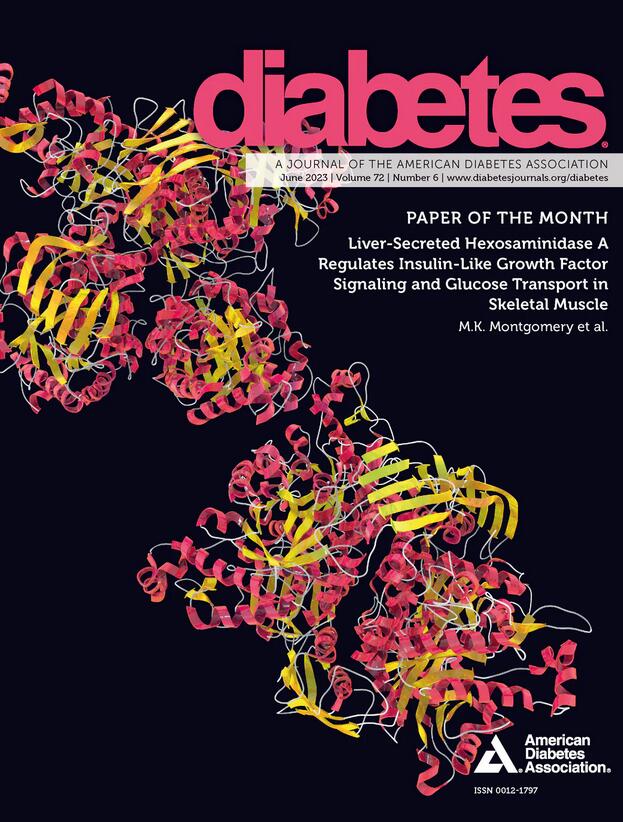1438-P:2008-2022 年美国卫生系统中 1 型糖尿病青少年和成人肥胖症和 GLP-1RA 的使用趋势
IF 6.2
1区 医学
Q1 ENDOCRINOLOGY & METABOLISM
引用次数: 0
摘要
引言& 目的:由于有关 1 型糖尿病(T1D)用药的数据很少,我们旨在描述 2008-2022 年间美国青年和成年 T1D 患者的肥胖和胰高血糖素样肽-1 受体激动剂(GLP-1RA)使用趋势。方法:我们使用 Optum Labs 数据仓库中的去标识化电子健康记录数据,通过经过验证的算法确定了 T1D 患者。体重指数 (BMI) 的类别是根据青少年(2-19 岁)的年龄和性别特异性百分位数和成人(≥20 岁)的世界卫生组织标准确定的。我们按 BMI 类别描述了 2008-2010 年至 2020-2022 年超重和肥胖以及 GLP1-RA 处方的趋势。结果:我们纳入了 159879 名 T1D 患者(19% 为年轻人,平均年龄 39 岁,49% 为女性,77% 为非西班牙裔白人)。从 2008-2010 年到 2020-2022 年,青少年肥胖率从 19% 上升到 26%(P<.001),严重肥胖率从 4% 上升到 11%(P<.001)(图 A)。成人肥胖率从 2008-2010 年的 28% 上升到 2020-2022 年的 37%(P<.001)(图 B)。在过去 15 年中,GLP-1RA 的使用率迅速上升,尤其是在重度肥胖症中(图 C-D)。2020-2022 年,18% 的青少年和 34% 的成人重度肥胖症患者使用 GLP-1RA。结论肥胖在 T1D 患者中已达到流行病水平。随着时间的推移,GLP-1RA 的标签外处方显著增加,尤其是在重度肥胖症患者中。需要更多有关 GLP-1RA 在 T1D 患者中效果的数据。披露 Y. Xu:无。M. Fang:无。J. Coresh:顾问;SomaLogic、Healthy.io。M. Grams:M.Grams:无。E. Selvin:无。J. Shin:无。本文章由计算机程序翻译,如有差异,请以英文原文为准。
1438-P: Trends in Obesity and GLP-1RA Use among Youth and Adults with Type 1 Diabetes in U.S. Health System—2008–2022
Introduction & Objective: As data on medication use in type 1 diabetes (T1D) is scarce, we aimed to characterize trends in obesity and glucagon-like peptide-1 receptor agonists (GLP-1RA) use among US youth and adults with T1D from 2008-2022. Methods: We identified patients with T1D using a validated algorithm using deidentified electronic health record data from the Optum Labs Data Warehouse. Body mass index (BMI) categories were based on age- and sex-specific percentiles for youth (2-19 years) and WHO criteria for adults (≥20 years). We characterized trends in overweight and obesity, and GLP1-RA prescriptions by BMI categories from 2008-2010 to 2020-2022. Results: We included 159,879 patients with T1D (19% youth, mean age 39 years, 49% female, 77% non-Hispanic White). From 2008-2010 to 2020-2022, obesity in youth increased from 19% to 26% (P<.001), and severe obesity from 4% to 11% (P<.001) (Figure A). In adults, obesity rose from 28% in 2008-2010 to 37% in 2020-2022 (P<.001) (Figure B). There was a rapid uptake of GLP-1RA over the last 15 years, particularly in severe obesity (Figure C-D). In 2020-2022, GLP-1RA was used by 18% of youth and 34% of adults with severe obesity. Conclusion: Obesity has reached epidemic levels in patients with T1D. The off-label prescription of GLP-1RA significantly increased over time, especially in severe obesity. More data on GLP-1RA's effects in the T1D population is needed. Disclosure Y. Xu: None. M. Fang: None. J. Coresh: Consultant; SomaLogic, Healthy.io. M. Grams: None. E. Selvin: None. J. Shin: None.
求助全文
通过发布文献求助,成功后即可免费获取论文全文。
去求助
来源期刊

Diabetes
医学-内分泌学与代谢
CiteScore
12.50
自引率
2.60%
发文量
1968
审稿时长
1 months
期刊介绍:
Diabetes is a scientific journal that publishes original research exploring the physiological and pathophysiological aspects of diabetes mellitus. We encourage submissions of manuscripts pertaining to laboratory, animal, or human research, covering a wide range of topics. Our primary focus is on investigative reports investigating various aspects such as the development and progression of diabetes, along with its associated complications. We also welcome studies delving into normal and pathological pancreatic islet function and intermediary metabolism, as well as exploring the mechanisms of drug and hormone action from a pharmacological perspective. Additionally, we encourage submissions that delve into the biochemical and molecular aspects of both normal and abnormal biological processes.
However, it is important to note that we do not publish studies relating to diabetes education or the application of accepted therapeutic and diagnostic approaches to patients with diabetes mellitus. Our aim is to provide a platform for research that contributes to advancing our understanding of the underlying mechanisms and processes of diabetes.
 求助内容:
求助内容: 应助结果提醒方式:
应助结果提醒方式:


